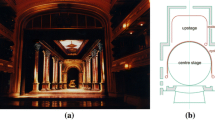Abstract
Museums are attracted by new technologies, for example tracking systems and multitouch displays. They try to include them into their concepts, to expand the access to the artifacts. The intention of this work appears out of the image geometry of a linear perspective painting. We assume that the position of the perspective painting on the wall should depend on the observer’s viewpoint. To prove this hypothesis we undertook an experiment with 20 participants and four perspective paintings. We detected a relevant connection between observer and the image geometry of the painting. Accordingly the observer, the room in front of the painting and the image itself are related together. Therefor this relation of the parameters is part of the research field of embodied interaction.
Chapter PDF
Similar content being viewed by others
References
Antle, A.N., Marshall, P., Hoven, E.: Workshop on Embodied Interaction: Theory and Practice in HCI. In: Proceedings of the Conference on Human Factors in Computing Systems (CHI 2011), pp. 5–8. ACM, New York (2011)
Hornecker, E.: The Role of Physicality in Tangible and Embodied Interactions. Interactions 18(2), 19–23 (2011)
Kortbek, K.J., Grønbæk, K.: Communicating Art through Interactive Technology: New Approaches for Interaction Design in Art Museums. In: Proceedings of the 5th Nordic Conference on Human-Computer Interaction: Building Bridges (NordiCHI 2008), pp. 229–238. ACM, New York (2008)
Fogtmann, M.H., Fritsch, J., Kortbek, K.J.: Kinesthetic Interaction – Revealing the Bodily Potential in Interaction Design. In: Proceedings of the 20th Australasian Conference on Computer-Human Interaction: Designing for Habitus and Habitat (OzCHI 2008), pp. 89–96. ACM, New York (2008)
Schieck, A.F.G., Moutinho, A.M.: ArCHI: Engaging with Museum Objects Spatially Through Whole Body Movement. In: Proceeding of the 16th International Academic MindTrek Conference (MindTrek 2012), pp. 39–45. ACM, New York (2012)
International Council of Museums: Statutes, Vienna (2007)
Field, J.V.: The invention of infinity: Mathematics and Art in the Renaissance. Oxford University Press Inc., New York (1997)
da Vignola, G.B.: Two rules of practical perspective, Bologna (1583)
Veltman, K.H.: Computers and Renaissance Perspective. Centro Ricerche Leonardiane, Brescia (1993)
Calter, P.: Squaring the Circle: Geometry in Art & Architecture. Wiley, Hoboken (2008)
Arnheim, R.: The Power of the Center: A Study of Composition in the Visual Arts. University of California Press, Berkeley (1982)
Ishii, H.: Tangible Bilts: Beyond Pixels. In: Proceedings of the 2nd International Conference on Tangible and Embedded Interaction (TEI 2008), pp. xv–xxv. ACM, New York (2008)
Author information
Authors and Affiliations
Editor information
Editors and Affiliations
Rights and permissions
Copyright information
© 2013 Springer-Verlag Berlin Heidelberg
About this paper
Cite this paper
Hannß, F., Groh, R. (2013). Understanding the Influence of Viewpoint and Image Geometry in Linear Perspective Paintings to Enhance Embodied Interaction. In: Streitz, N., Stephanidis, C. (eds) Distributed, Ambient, and Pervasive Interactions. DAPI 2013. Lecture Notes in Computer Science, vol 8028. Springer, Berlin, Heidelberg. https://doi.org/10.1007/978-3-642-39351-8_2
Download citation
DOI: https://doi.org/10.1007/978-3-642-39351-8_2
Publisher Name: Springer, Berlin, Heidelberg
Print ISBN: 978-3-642-39350-1
Online ISBN: 978-3-642-39351-8
eBook Packages: Computer ScienceComputer Science (R0)




